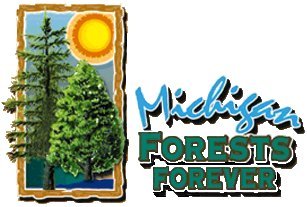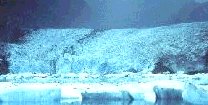

MICHIGAN FORESTS FOREVER TEACHERS GUIDE
| MICHIGAN FORESTS DURING THE ICE AGE |
 |
| Forest Timeline |
| Ice Age |
| Pre-Settlement |
| Logging Era |
| Conservation |
| Modern Forestry |
It's
pretty easy to imagine what forests looked like during the Ice Age. There were no
forests! At least not in what we now call Michigan. In fact, there wasn't much
in the way of living things at all. Michigan was covered with as much as a mile of
ice!
So, where were all the trees and other living things that make up our forests today? Glaciers cooled nearby areas so that northern species could live farther and farther south as the glaciers advanced. Remember that the process of glaciation took thousands of years. It didn't happen overnight. As the global climate cooled, snow and ice built up in the north. When the climate warmed up, the forests moved back north.
About 12,000 years ago, behind the retreating glaciers, a new landscape was exposed. The Great Lakes filled deep depressions left by the glaciers. The rocks, gravel, and soil in the ice sheets were either pushed by the ice or were deposited in hills called moraines, drumlins, eskers, and kames. Also, the crust of the Earth rose after the massive weight of ice disappeared. Water flowed all over the land leaving a new set of soils for trees and plants to establish themselves. The pattern of these glacial deposits have a strong influence on the kinds of forests we see in Michigan today.
In North America, there were no barriers to block the forest species as they moved north and south. But this wasn't the case all over the world. In Europe, for instance, the mighty Alps prevented many northern species from gradually moving south. They got squashed between the glaciers and the mountains! When the glaciers began to retreat, the northern forests of Europe were left with a lot fewer species than the northern forests of North America.
Not all tree species moved back north at the same rate. The light seeded species came back first, such as aspen. Species such as oak, took a lot longer to return. One way that scientists know this is from examining ancient pollen grains trapped in the muck of bogs and old lake bottoms. It's kind of cool how they have figured this stuff out!
Since the glaciers left Michigan, our forests have been constantly changing. There have been drier and wetter periods that affected the forest. But that's more of the story in the "pre-settlement" part of this website. The important point to keep in mind is that our forests have always been on the move. They never stayed one way for too long (at least in geologic time!).
 |
This website was developed and created by Michigan State University Extension for the teachers of the State of Michigan. |